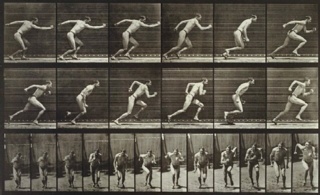time - A
nonspatial continuum in
which events occur in apparently irreversible succession from
the past through the present to the future. Or, either a point
or an interval in this continuum.
Related terms: duration, period, passage, epoch, era, age, season, cycle, instant, episode, incident, tempo, rhythm, beat, posterity, eternal, infinite, interminable, continuous, persistent, permanent, change, mutable, immutable, indestructable, posthumous, and immortal.
Time is an important factor in a number of art forms. It is crucial to literature (narrative, etc.), music, dance and theater of course. In visual art, time is an element in automata, mobiles, and kinetic sculpture; animation is a time-based art, as is cinema, video, and much of new media. An artist can imply the passage of time in a static piece of work by incorporating rhythm or periodicity, and when evoking history or the future (think about memories, metamorphoses, allegories, and palimpsests).
It is artificial to remove time from life, and various cultures have chosen to recognize annual observances of art-related events. Among these are artists' birthdays, and other specially designated days, weeks, and months of every year. Those on the following chart are officially recognized in the United States of America.
January |
Creativity Month |
February |
|
March |
Women's History Month |
April |
Garden Month Poetry Month |
May |
|
June |
Zoo and Aquarium Month |
July |
|
August |
|
September |
Success in School Month |
October |
Polish American History Month |
November |
|
December |
Read A New Book Month |
Examples of art concerned with time in various ways:

Paris, France, Watch: Young Louis XIV on Horseback,
c. 1650, enamel,
gold, diameter
2 5/16 inches (5.8 cm), Metropolitan Museum of Art, NY. See horology.

Eadweard Muybridge (American, born England,
1830-1904), Animal Locomotion Plate 59: Running Man, c. 1887, Minneapolis
Institute of Arts, photographs
taken by a series of cameras.
Muybridge printed
these as sheets of sequenced
exposures, although they are displayed here as if projected like
a movie — a technological development Muybridge is considered to have pioneered. See Eadweard Muybridge photos reproduced at the "Masters
of Photography" site. See movement.

Eadweard Muybridge, Jumping a hurdle; saddle; bay horse Daisy
Plate 640 of Animal Locomotion, 1887, collotype,
Worcester Art Museum, MA. See animation,
cinema, and equine
art.

Paul Manship (American, 1886-1966), Time and the Fates Sundial, 1938, bronze, National
Museum of American Art, Washington, D.C. See Art Deco.
Alexander Calder (American, 1898-1976). See mobile.

Joseph Kosuth (American, 1945-), Clock (One and Five), English / Latin
version, 1965, clock, photograph
and printed texts on paper,
unique, 61.0 x 290.2 cm,
Tate Gallery, London. See conceptual
art and horology.
Timelines:
Also see art conservation, art restoration, choose, four-dimensional, chronology, heritage, horology, kinesiologist, measure, movement, science and art, space-time, and tradition.
https://inform.quest/_art